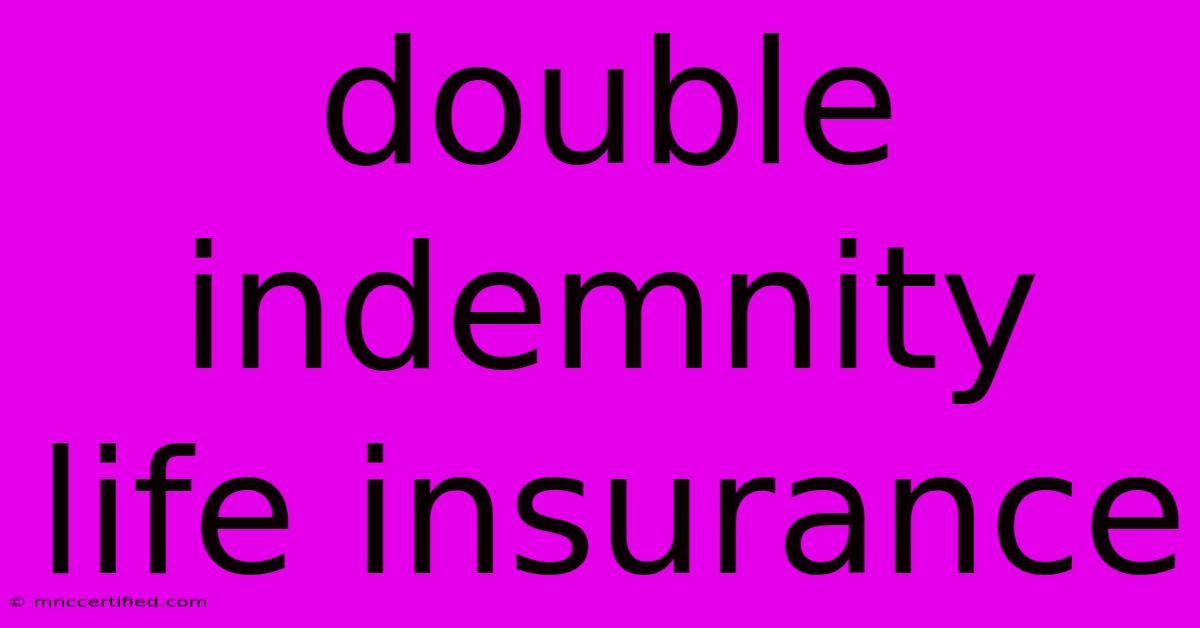Double Indemnity Life Insurance

Table of Contents
Double Indemnity Life Insurance: A Comprehensive Guide
Double indemnity life insurance is a rider or add-on to a standard life insurance policy that doubles the death benefit payout under specific circumstances. This typically involves accidental death, offering crucial financial protection for your loved ones in the event of an unforeseen tragedy. Understanding its intricacies, benefits, and limitations is crucial before adding it to your policy. This guide will delve into the essential aspects of double indemnity life insurance, equipping you to make an informed decision.
What is Double Indemnity?
Double indemnity is a provision that multiplies the death benefit payable to your beneficiaries by two. This only occurs if your death results from a covered accident, as defined within your policy. It's important to note that it's not a separate insurance policy; it's an added feature to your existing life insurance plan. Think of it as an enhanced safety net, providing extra financial security in the event of an accidental death.
How Does Double Indemnity Work?
The process is straightforward:
- Policy Purchase: You add the double indemnity rider to your chosen life insurance policy during the application process.
- Accidental Death: If you die as a direct result of an accident covered by the rider, your beneficiaries will receive double the stated death benefit.
- Claim Process: Your beneficiaries will need to provide evidence of accidental death to the insurance company, following the claim process outlined in your policy documents. This usually involves providing official documentation like a coroner's report or police report.
Key Considerations When Choosing Double Indemnity
- Definition of Accident: Carefully review your policy's definition of "accident." Exclusions are common and might include deaths resulting from pre-existing conditions, suicide, or participation in high-risk activities. Some policies might exclude deaths caused by certain types of accidents (e.g., those involving motor vehicles under specific circumstances).
- Additional Cost: Double indemnity isn't free. It increases your monthly premiums. Carefully weigh the extra cost against the potential benefit.
- Alternatives: Consider whether other financial planning strategies could provide similar protection at a potentially lower cost. A higher death benefit on your standard policy might be more cost-effective.
- Eligibility: Not everyone qualifies for double indemnity. Insurance companies assess risk factors and may deny applications based on your health, occupation, or lifestyle.
Advantages of Double Indemnity
- Financial Security: Provides a significant boost to the death benefit for accidental deaths, offering greater financial protection for your family. This can be particularly beneficial for families with young children or significant debts.
- Peace of Mind: Knowing you have this extra layer of protection can provide significant peace of mind, knowing that your loved ones will be better provided for in the event of an unexpected accident.
Disadvantages of Double Indemnity
- Increased Premiums: The most significant drawback is the higher premium. This added cost should be carefully considered and weighed against your budget.
- Limited Coverage: Double indemnity only covers accidental deaths. It does not provide additional benefits in case of death from illness or other non-accidental causes.
- Potential for Denial: Insurance companies thoroughly assess risk, and there's a chance your application for double indemnity may be denied based on your individual circumstances.
Double Indemnity vs. Accidental Death Benefit
While often used interchangeably, there's a subtle difference. Accidental death benefit is a more general term that may or may not double the death benefit. Some accidental death benefits pay a fixed amount, while others might offer a percentage increase of the death benefit. Double indemnity, however, specifically refers to a doubling of the death benefit.
Is Double Indemnity Right for You?
The decision to add double indemnity depends entirely on your individual circumstances and financial goals. Carefully evaluate your risk tolerance, budget constraints, and family needs. Compare the costs and benefits against alternative financial strategies. Consult with a financial advisor to determine if double indemnity aligns with your overall financial plan.
Frequently Asked Questions (FAQs)
- Q: Can I add double indemnity to an existing policy? A: This depends on your insurer and the terms of your current policy. Contact your insurer directly to inquire about adding the rider.
- Q: What if I die from a combination of accident and illness? A: This would likely be determined on a case-by-case basis by the insurance company, depending on the specifics of your policy and the cause of death. The policy's definition of "accident" will be critical in such scenarios.
- Q: How long does double indemnity coverage last? A: Typically, as long as your underlying life insurance policy remains in force.
By carefully considering these factors, you can make an informed decision about whether double indemnity life insurance is a suitable addition to your financial protection strategy. Remember to consult with a financial professional for personalized advice tailored to your specific needs.

Thank you for visiting our website wich cover about Double Indemnity Life Insurance. We hope the information provided has been useful to you. Feel free to contact us if you have any questions or need further assistance. See you next time and dont miss to bookmark.
Featured Posts
-
Hanekoms Summit Green Future Begins
Nov 23, 2024
-
Woman Wins Mc Gregor Rape Case
Nov 23, 2024
-
Close Call Russell Verstappen In Vegas F1 Pole Battle
Nov 23, 2024
-
Grinch Happy Meal Skipping The Usa
Nov 23, 2024
-
Treasure And Bond Sweater Dress
Nov 23, 2024